Cold process soap should reach 120°F-130°F when mixing oils and lye solution for ideal results. Keep both components within 10°F of each other to prevent false trace. For milk soaps or delicate additives, work cooler (100°F-110°F), while higher temperatures (131°F-160°F) promote gel phase for vibrant colors. During saponification, temperatures may naturally rise to 180°F in the mold. Proper temperature management will help you avoid common issues like soda ash, separation, and soap volcanoes.
The Ideal Temperature Range for Cold Process Soap
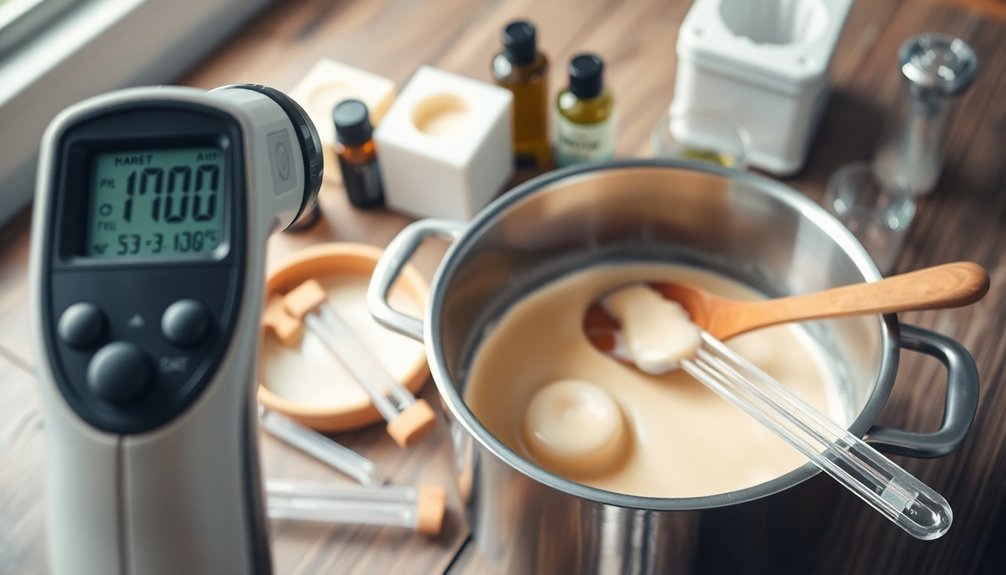
When making cold process soap, temperature precision matters more than you might think. The ideal temperature range for cold process soap typically falls between 120°F and 130°F for both your oils and lye solution. This range guarantees proper saponification process while maintaining control over your batch.
You'll want to keep your oils and lye solution temperatures within 10 degrees of each other to prevent issues like false trace and guarantee smooth mixing.
If you're working with heat-sensitive additives like milk or plant extracts, consider a cooler approach (100°F-110°F) to prevent scorching and discoloration.
For vibrant colors and reduced soda ash, higher temperatures (131°F-160°F) promote gel phase.
Different soap making oils may respond differently to temperature, so adjust accordingly as you gain experience.
Understanding Gel Phase and Heat Management
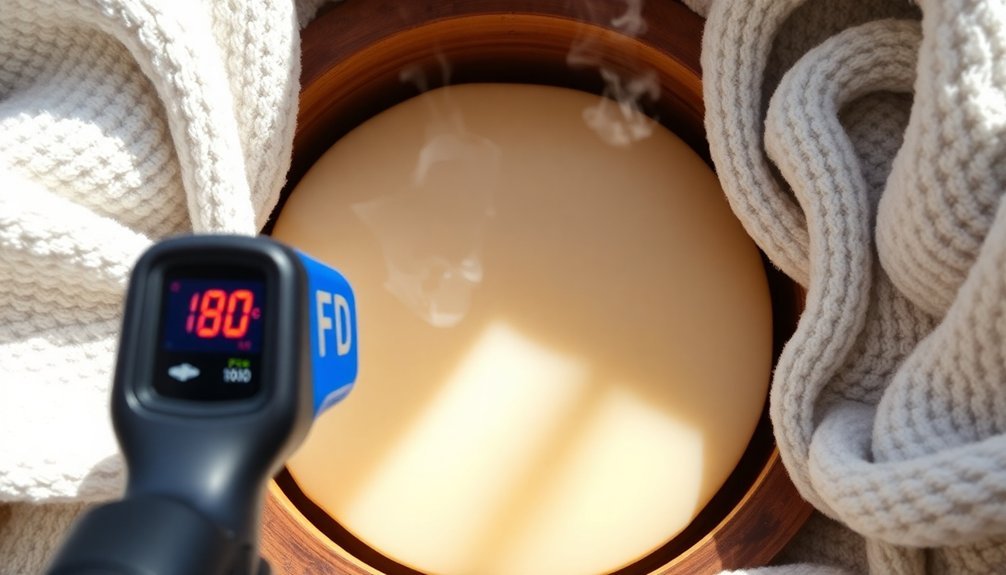
Gel phase transforms your soap with temperatures reaching up to 180°F, resulting in vibrant colors and a shinier finish you'll love.
You can control this process by insulating your soap in loaf molds at 120-130°F to promote ideal saponification.
Keep a watchful eye on your batch, though, as overheating can cause wrinkly textures or soap that overflows from your molds.
Gel Phase Basics
The mysterious gel phase represents a critical heating period during saponification where your soap can reach temperatures up to 180°F. During this process, your soap transforms into a gelatinous state, promoting vibrant colors and creating a shiny appearance in your finished bars.
As a soap maker, you'll need to manage insulation carefully to maintain ideal heat. Loaf molds naturally retain heat better than cavity molds, making them perfect for achieving gel phase. In colder environments, consider using a drawer or heating pad to boost insulation around your soap.
Monitor your batch about 30 minutes after insulation—it should feel warm and appear gelatinous. If it's cooling too quickly, add more insulation.
Be cautious of overheating though, as temperatures that climb too high can cause wrinkly textures or lye-heavy soap to overflow.
Temperature Control Methods
Four essential techniques help you control temperatures during the critical gel phase.
First, start with lye and oils at 120-130°F when mixing your cold process soap to create favorable conditions for heat development.
Second, choose your mold type strategically—loaf molds naturally retain more heat than cavity molds, making them ideal for achieving gel phase.
Third, implement proper insulating methods by wrapping your mold with towels immediately after pouring, and consider adding a heating pad for additional warmth if needed.
Finally, monitor your soap's temperature within the first 30 minutes after insulation. If it's not warming up (ideally heading toward 180°F), add more insulation.
Conversely, if you notice signs of overheating like wrinkling or overflow, quickly remove insulation and cool the soap to prevent texture issues.
Prevent Overheating Issues
While achieving gel phase offers benefits like vibrant colors and a glossy finish, managing heat properly prevents potential soap disasters. When temperatures rise above 180°F during gel phase, you'll notice warning signs like soap rising from molds or developing a wrinkly texture.
To avoid these issues, monitor temperatures throughout the process. If you spot overheating, immediately transfer your soap molds to a freezer to halt temperature escalation. Conversely, insufficient heat can lead to false trace and unsaponified lye – equally problematic outcomes.
Balance your insulation approach based on your environment. In cooler rooms, use towels, boxes, or heating pads to maintain perfect temperature; in warmer conditions, reduce insulation accordingly.
This careful attention to temperature control guarantees your soap experiences ideal gel phase without crossing into problematic territory.
How Temperature Affects Trace Development
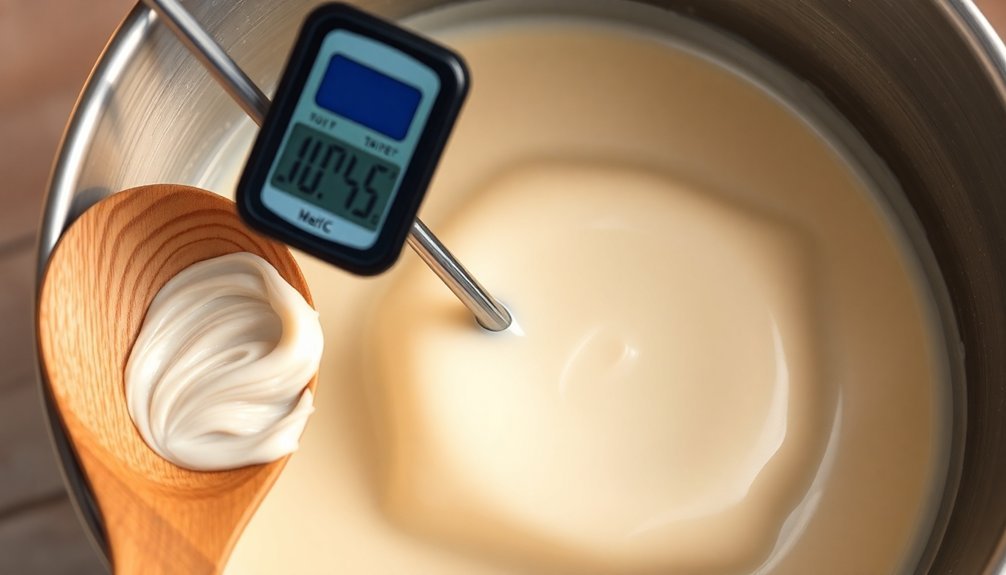
Because temperature directly influences chemical reactions, maintaining proper heat levels during soap making dramatically impacts how quickly your mixture reaches trace.
When you keep both your lye solution and oils within the ideal 120-130°F range, you'll achieve consistent trace development that's perfect for creating beautiful soaps.
Temperature imbalances can cause several issues in the process:
- Cold lye solution (below 120°F) – Can solidify oils on contact, creating false trace that appears thick but hasn't actually saponified.
- Hot lye solution (above 130°F) – Accelerates saponification, causing rapid trace that limits design options.
- Temperature difference greater than 10°F – May lead to separation problems and inconsistent trace development.
Maintaining proper heat guarantees your soap reaches true trace at a predictable rate, giving you control over the process and final appearance.
Monitoring Your Soap's Temperature Throughout Saponification
Once your soap mix enters the mold, the real thermal journey begins as saponification generates its own heat.
You'll want to maintain the temperature between 120-130°F to guarantee proper gel phase development. After pouring your soap batter, check it at 30-minute intervals—look for warmth and a gelatinous appearance that indicates successful saponification.
If your soap feels cool or shows no signs of gelling, add more insulation to retain heat. Conversely, watch for overheating symptoms like a wrinkly texture or soap rising from the mold. In these cases, quickly cool it by placing it in your freezer.
Remember that keeping temperatures above 120°F not only prevents soda ash formation but also improves color vibrancy.
Don't forget to factor in your room's temperature and humidity, as environmental conditions considerably impact the saponification process.
Temperature Considerations for Different Oil Blends
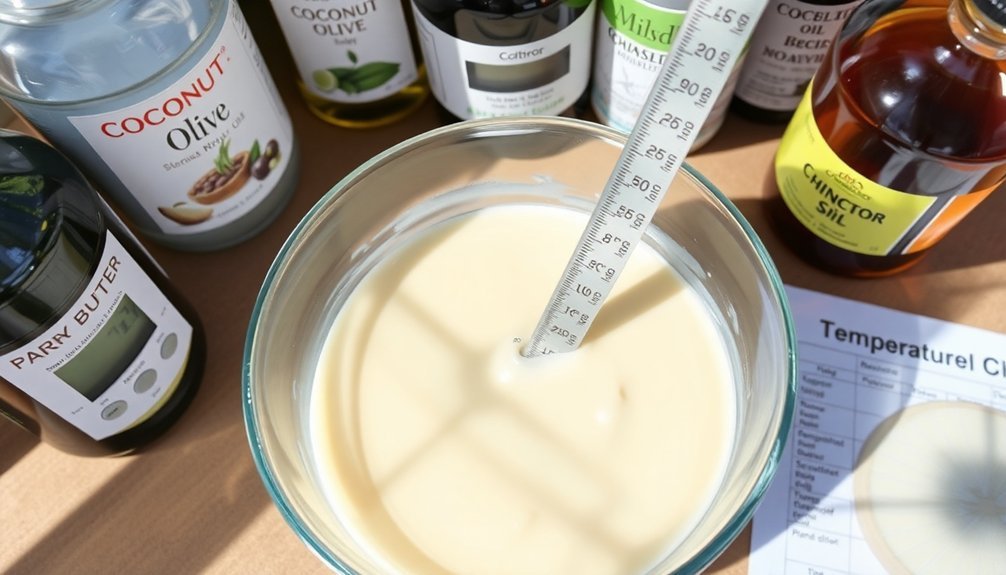
Different oil blends require specific temperature adjustments in your cold process soap making, with hard oils like cocoa butter needing complete melting while liquid oils work well at room temperature.
You'll want to maintain your hard oils between 120°F-130°F to prevent false trace, while keeping softer oils within 10 degrees of your lye solution temperature.
This temperature management becomes particularly important when working with mixed recipes, as variations in oil composition directly affect how quickly your soap reaches trace and its final texture.
Hard vs. Soft Oils
Two distinct categories of oils create unique temperature challenges in cold process soap making.
Hard oils like cocoa butter and palm oil have higher melting points and require careful temperature management, while soft oils such as olive and coconut remain liquid at room temperature, offering more flexibility during saponification.
When working with both types in your recipe, consider:
- Melting points – Hard oils need to reach temperatures above their melting point (cocoa butter at 93°F) to fully liquefy.
- Combined temperatures – Aim for 120-130°F when mixing hard and soft oils to prevent false trace.
- Lye solution temperature – Keep your lye at or slightly above your oil temperature, especially essential when working with oils high in stearic acid.
Understanding these differences helps you maintain proper temperatures throughout your soap making process.
Temperature Window Ranges
As you formulate your soap recipes with various oil combinations, finding the perfect temperature window becomes essential for successful saponification. For most cold process soaps, aim to have both your lye water and oils within 120-130°F (49-54°C). This range guarantees proper integration and helps avoid false trace.
When working with solid oils like cocoa or shea butter, make sure they're fully melted before combining with your lye water. For mixed recipes containing both hard and soft oils, a moderate 100°F (38°C) often provides the ideal balance.
High temperatures between 131-160°F promote gel phase, enhancing color vibrancy in your final bars. Conversely, cooler temperatures (100-110°F) prevent overheating—particularly important when incorporating milk or sugar-rich ingredients.
Always monitor temperatures throughout your process, as deviations can lead to aesthetic issues like soda ash or glycerin rivers.
Adjusting Temperature for Special Ingredients and Additives
Special ingredients demand specific temperature considerations to preserve their beneficial properties and prevent unwanted reactions in your cold process soap.
When working with milk, keep temperatures below 100°F to avoid scorching that affects both color and scent. Similarly, recipes with natural sugars require temperatures under 120°F to prevent glycerin rivers and overheating.
Your additives will perform differently based on temperature adjustments:
- Clay and exfoliants – Aim for 110°F for ideal integration and performance
- Heat-generating essential oils – Cool your lye solution to 100-110°F to counteract additional heat
- Intricate designs – Work at 90-100°F to slow trace, giving you more control with decorative additives
Monitoring temperature isn't just about successful saponification—it's about preserving the integrity of your special ingredients throughout the process.
Tools and Techniques for Temperature Control
Now that you understand how temperature affects different additives, let's focus on the tools and methods for precise temperature management in your soap-making process. A digital laser thermometer is your best ally for accurately monitoring both lye and oils temperatures, ensuring they stay within 10 degrees of each other.
Consider melting your solid oils first before adding liquid oils to help control cooling rates. The heat transfer method offers an efficient approach—allowing the hot lye solution to naturally melt your solid oils, creating a smoother integration process.
For small batches that cool quickly, insulate your container to maintain heat and prevent false trace. This simple technique helps sustain the ideal soaping temperature range of 120-130°F, giving you more control over the saponification process and ultimately leading to better results.
Troubleshooting Common Temperature-Related Soap Problems
Even with careful preparation, temperature issues can derail your soap making process and lead to frustrating results.
When your oil mixture is too hot or your lye starts at considerably different temperatures, you'll encounter specific problems that affect your soap's quality.
Use your temperature gun regularly to identify and prevent these common issues:
- False trace occurs when lye temperatures are much lower than oils, creating a deceptive thickness that hasn't properly saponified—continue mixing until true trace occurs.
- Soda ash develops when cold soap batter reacts with carbon dioxide, creating a white film—maintain proper temperatures to avoid this aesthetic issue.
- Alien brain formations and soap volcanoes result when excessive heat from the lye causes the batch to enter gel phase too quickly—monitor and control temperature throughout the process.
Frequently Asked Questions
What Temperature Should Cold Process Soap Be?
Keep your cold process soap ingredients between 120°F and 130°F. You'll want to maintain both lye and oils within 10 degrees of each other to avoid false trace and guarantee proper saponification.
What Is the Optimum Temperature for Saponification?
For ideal saponification, you'll want to maintain temperatures between 120°F to 130°F for both your oils and lye solution. Keep them within 10 degrees of each other to guarantee a smooth, successful cold process soap batch.
What Happens if Cold Process Soap Gets Too Hot?
If your cold process soap gets too hot, you'll see alien brain formations, soap volcanoes, and glycerin rivers. Watch for wrinkly surfaces or soap rising from molds—signs it's exceeded the safe 120°F threshold.
What Temperature Should Soap Be Poured At?
You should pour your cold process soap when both the lye solution and oils reach 120-130°F (49-54°C). This temperature range guarantees proper saponification, prevents false trace, and promotes a successful gel phase for vibrant colors.
In Summary
You'll find success with cold process soap when keeping lye and oils between 90-120°F, depending on your recipe. Remember that higher temperatures accelerate trace and promote gel phase, while cooler temps give you more working time. Monitor throughout saponification and adjust for specific ingredients. With practice, you'll develop an intuition for the perfect temperature that works for your unique soap formulations.
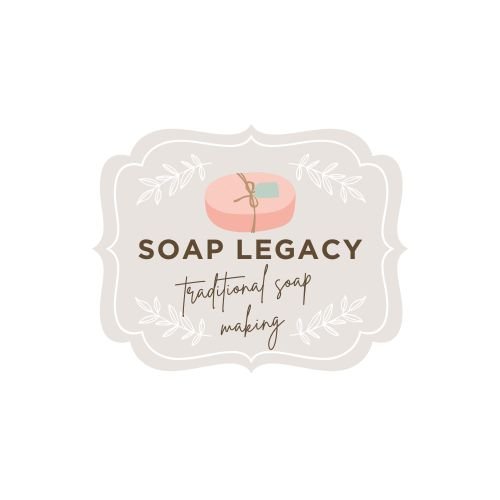
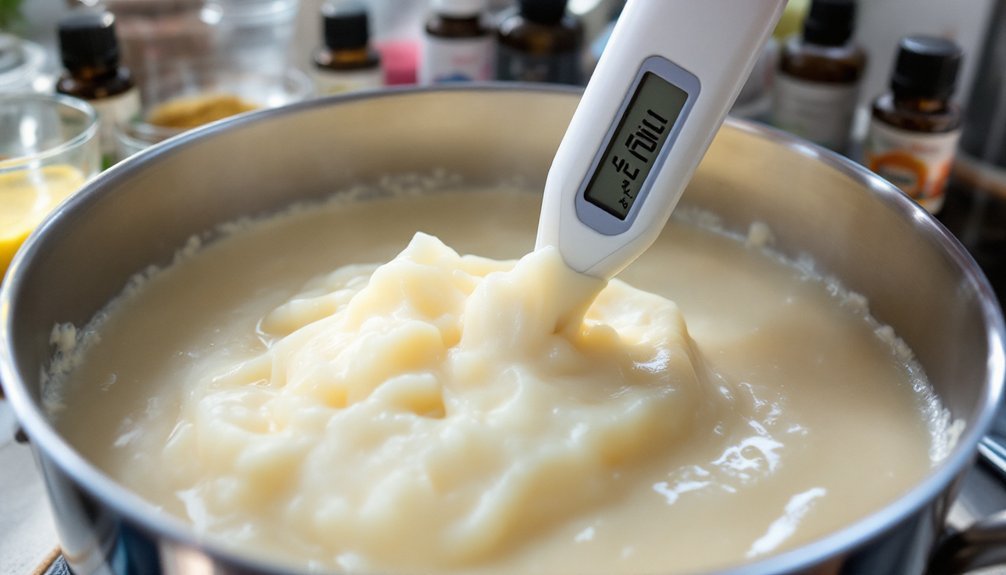


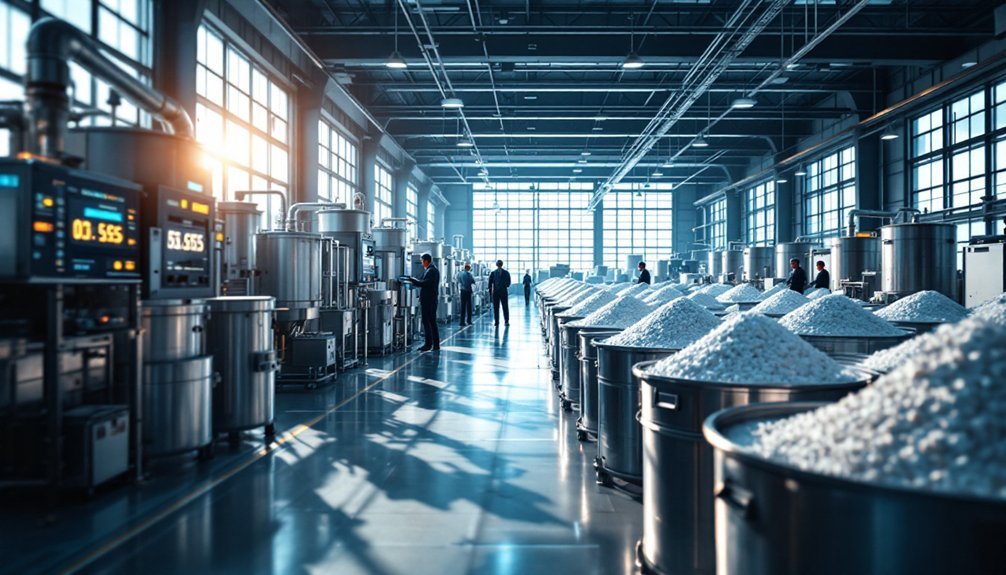
Leave a Reply